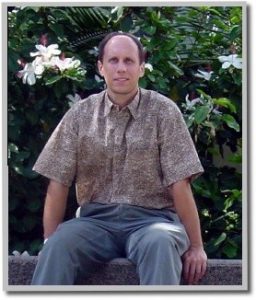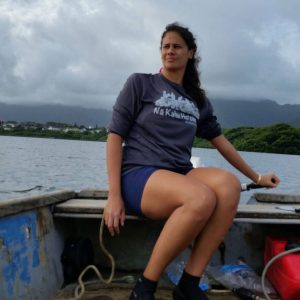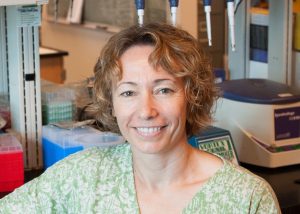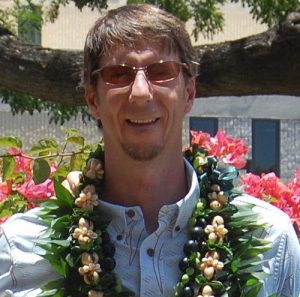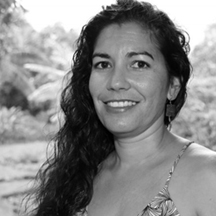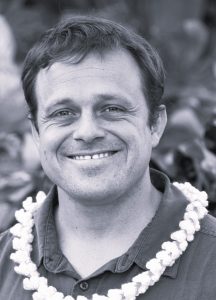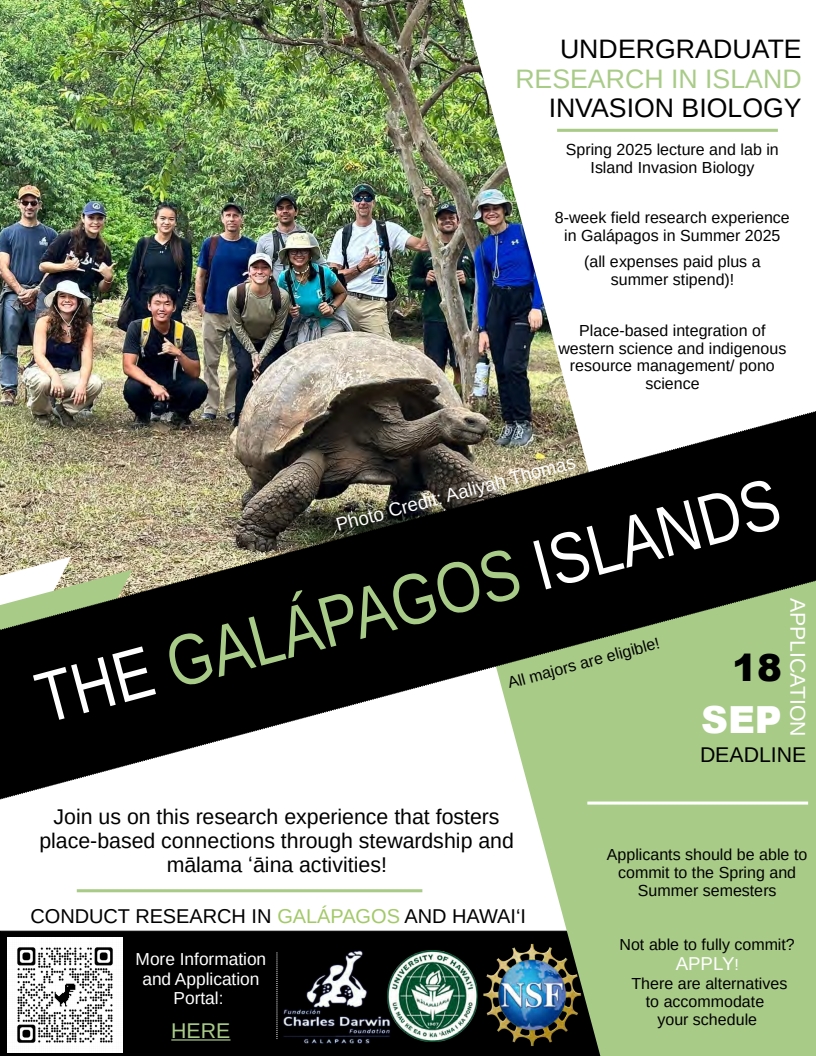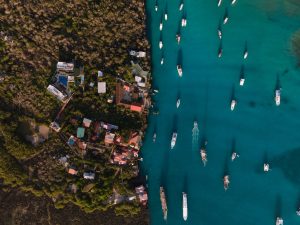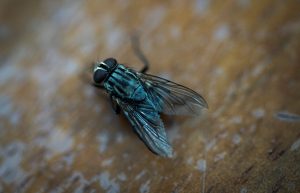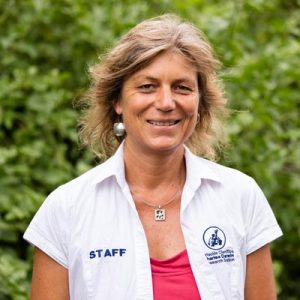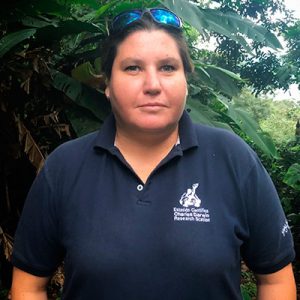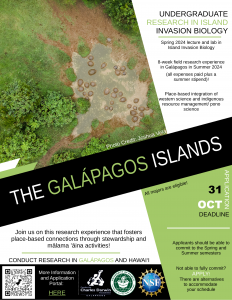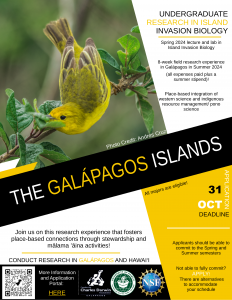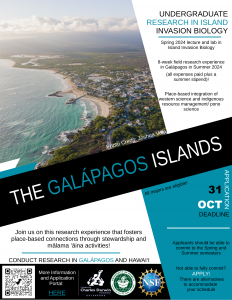NSF-IRES: Immersive research in Galápagos
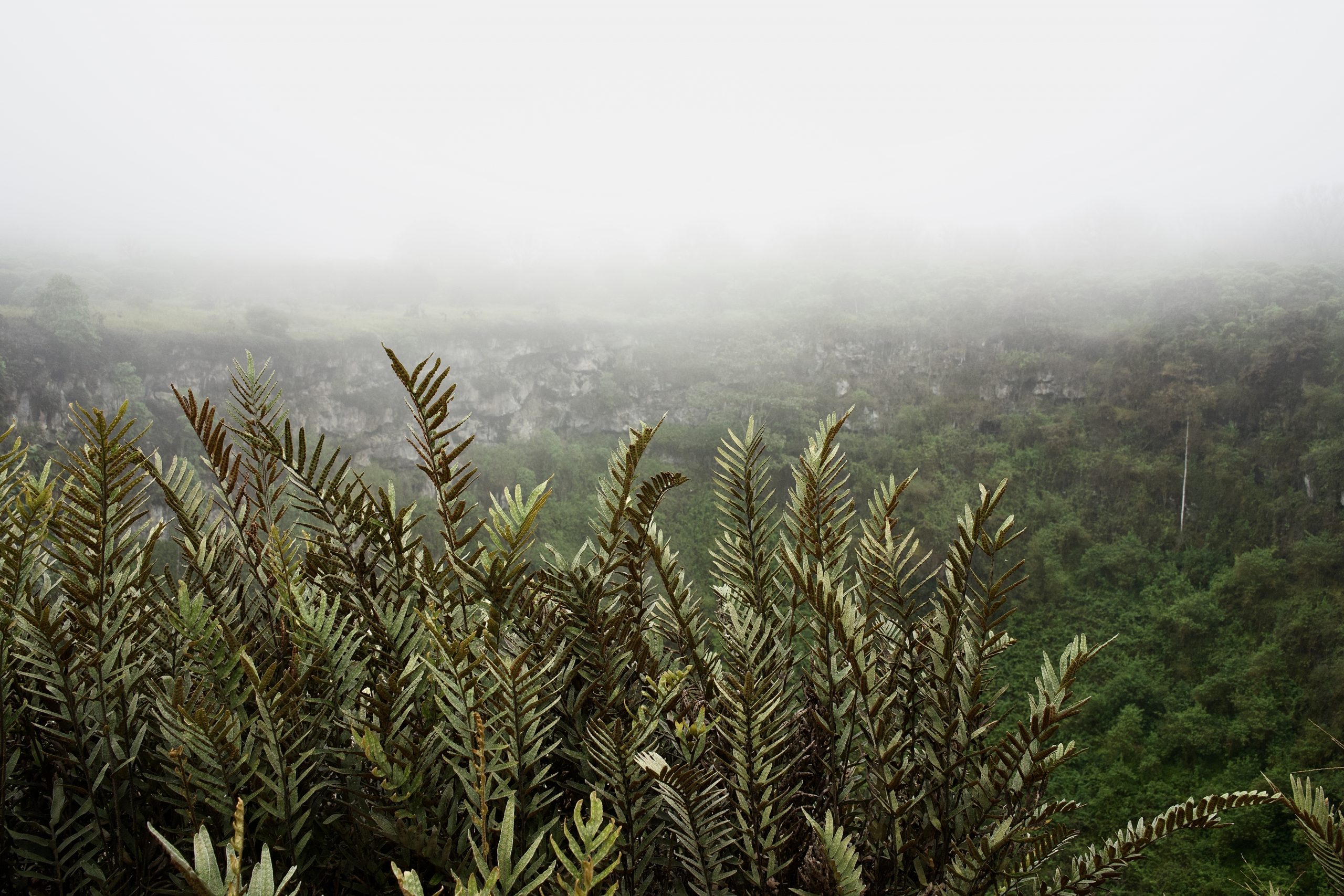
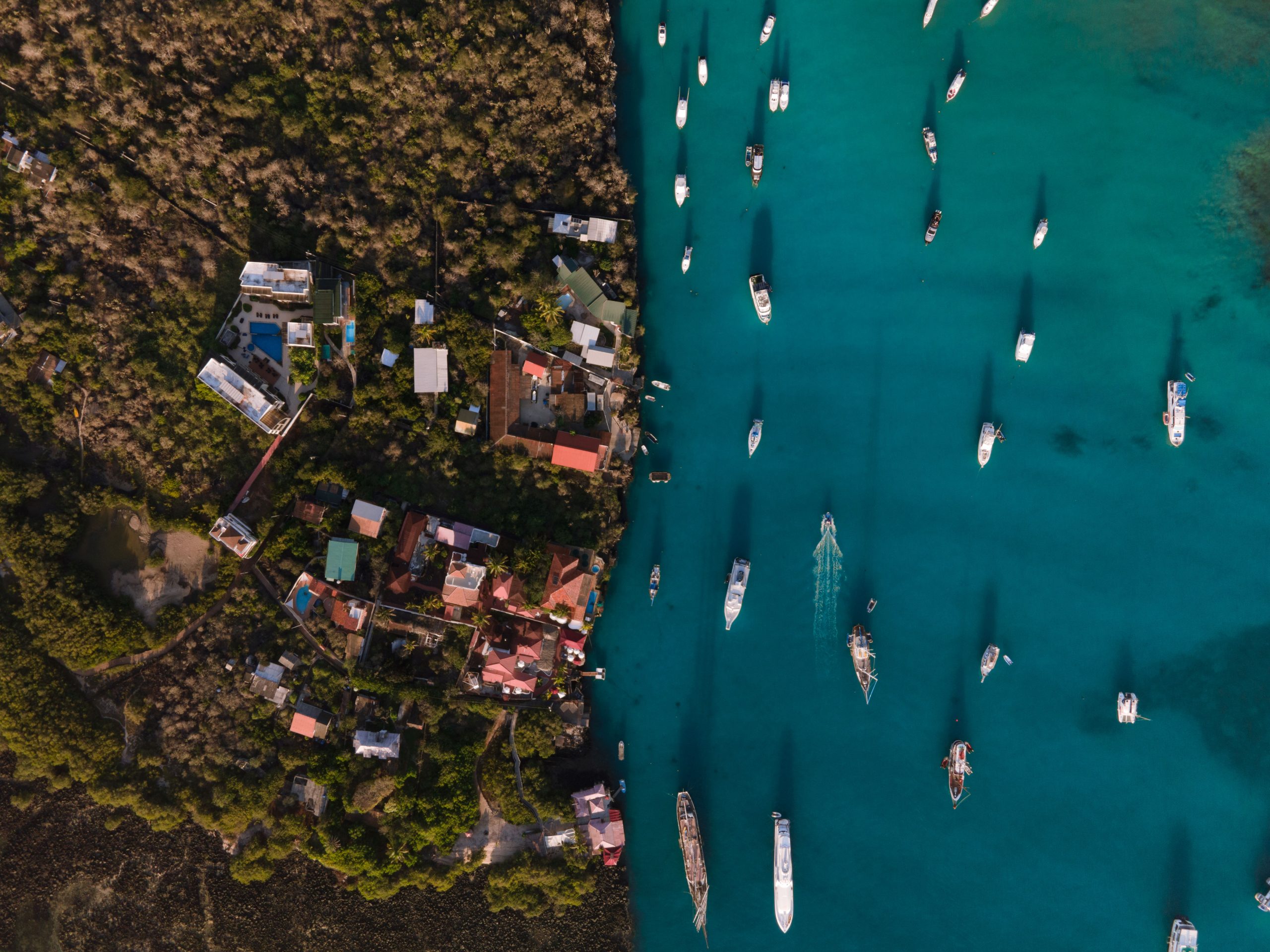

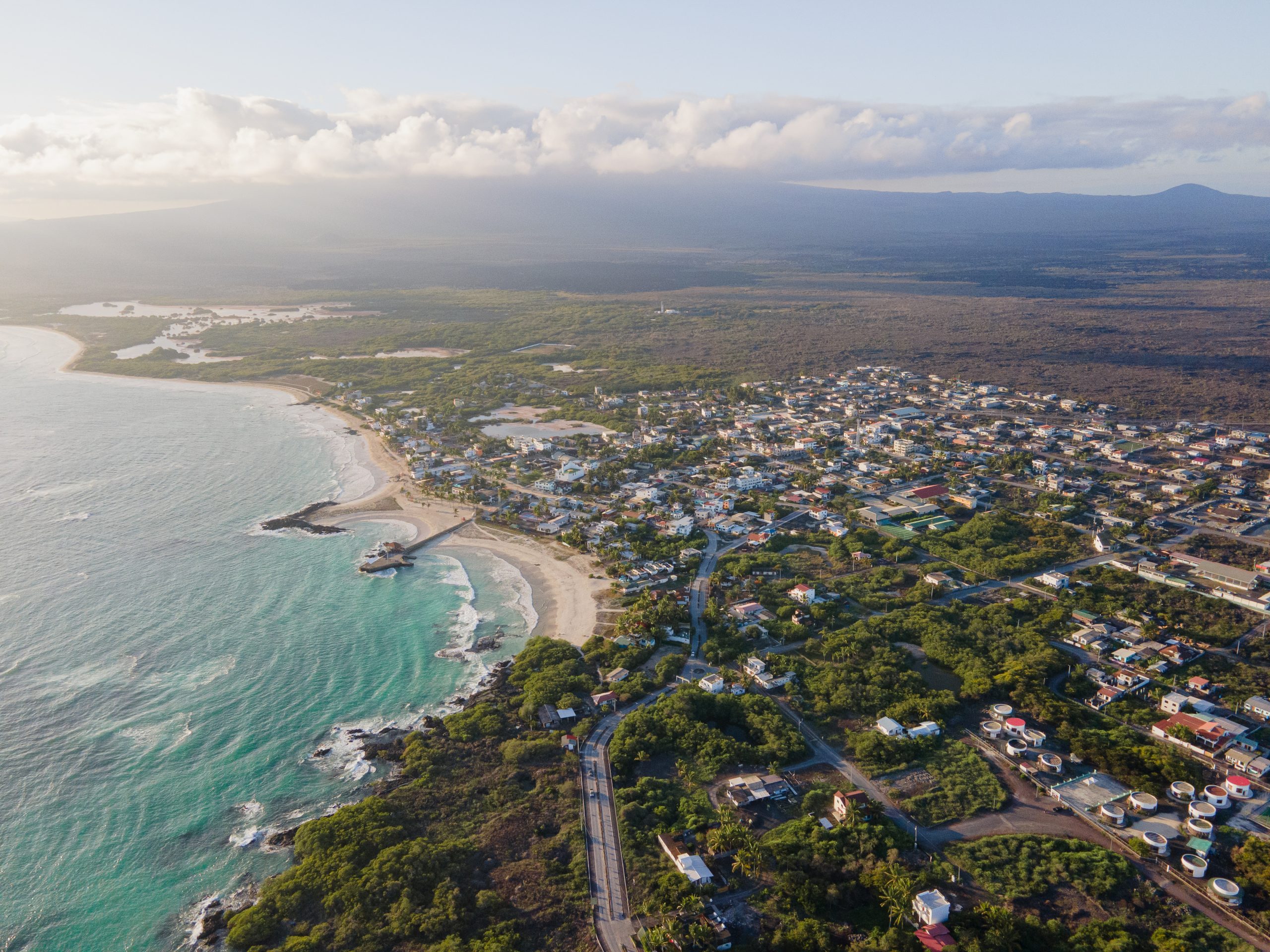
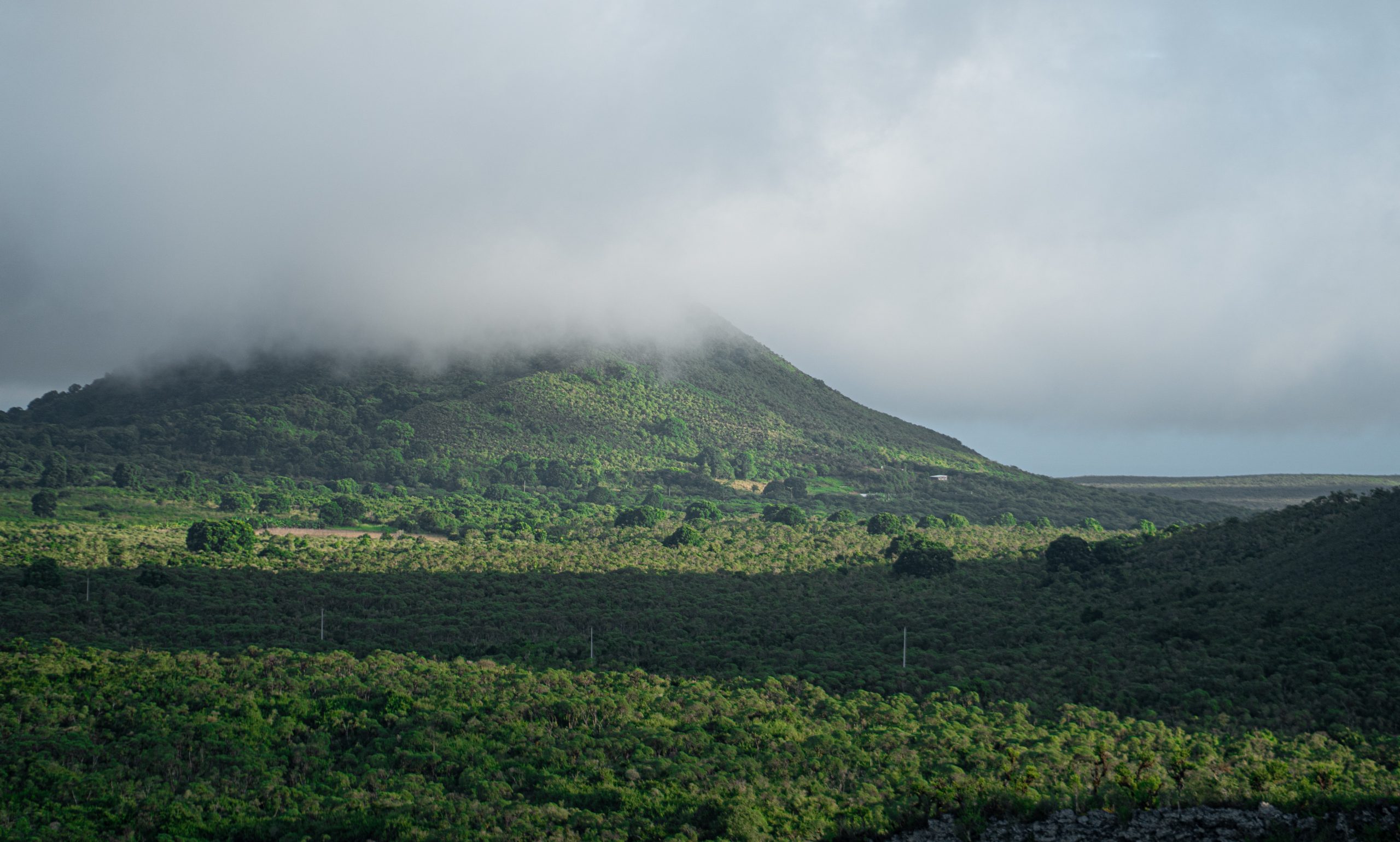
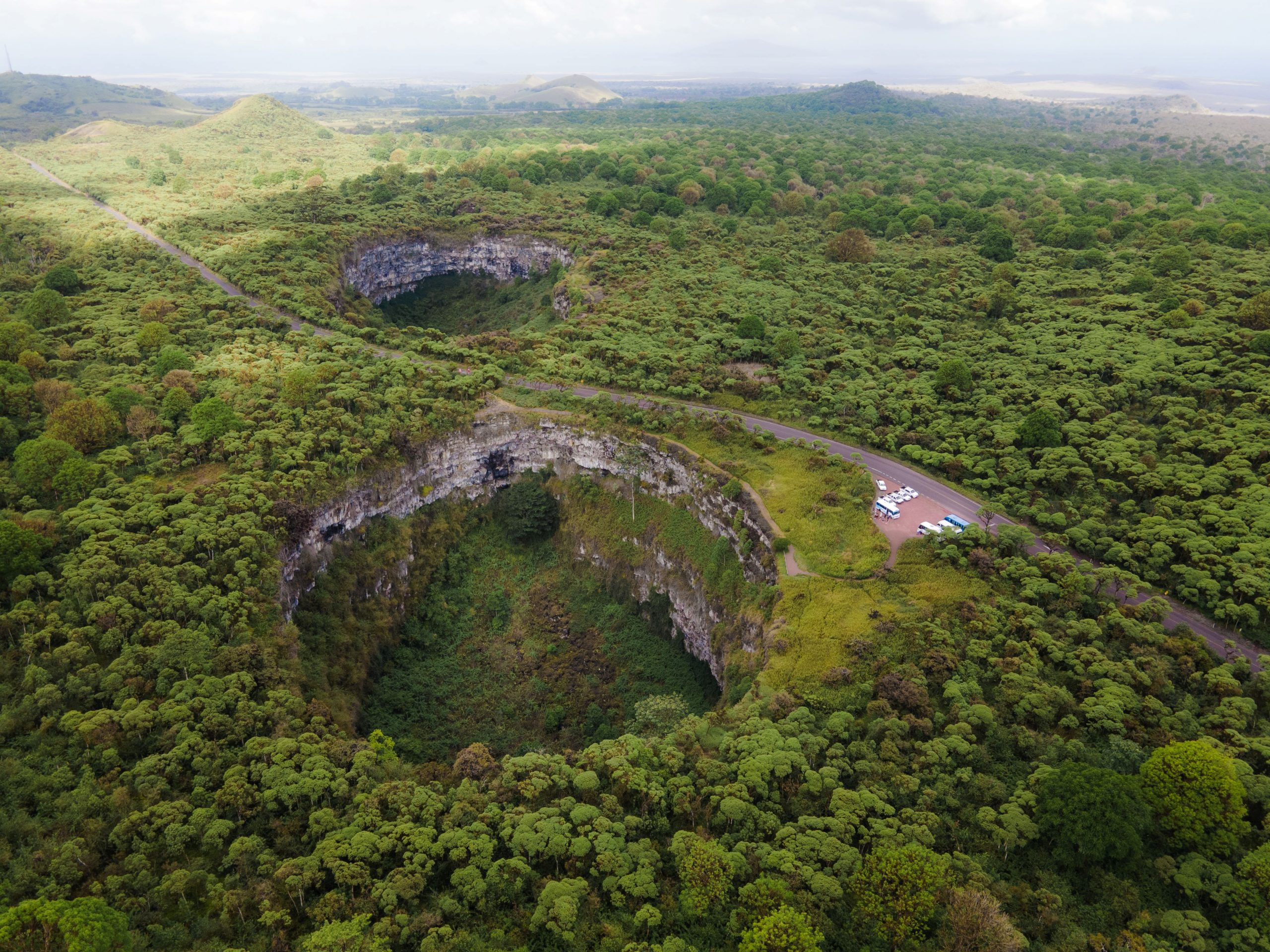

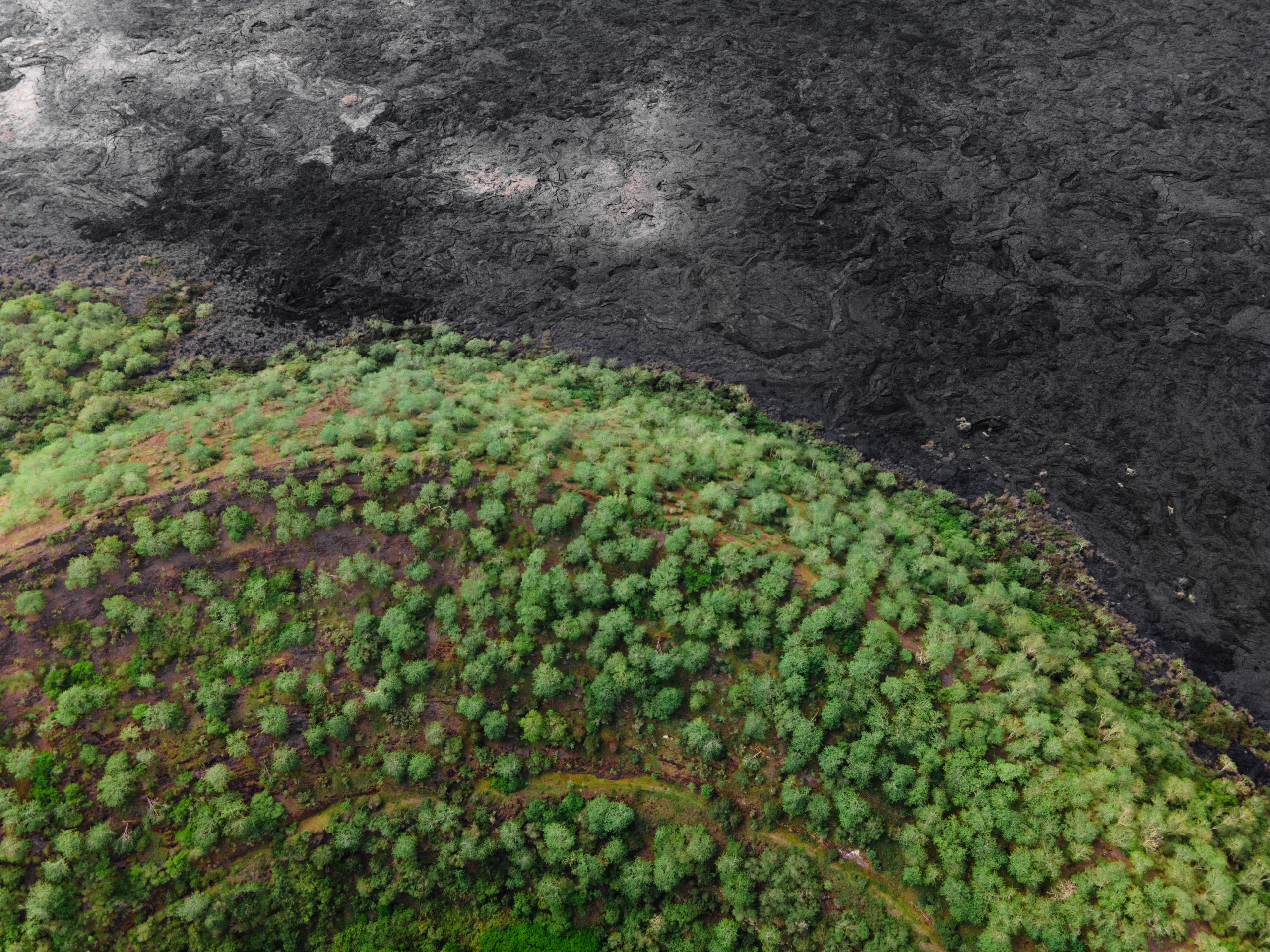
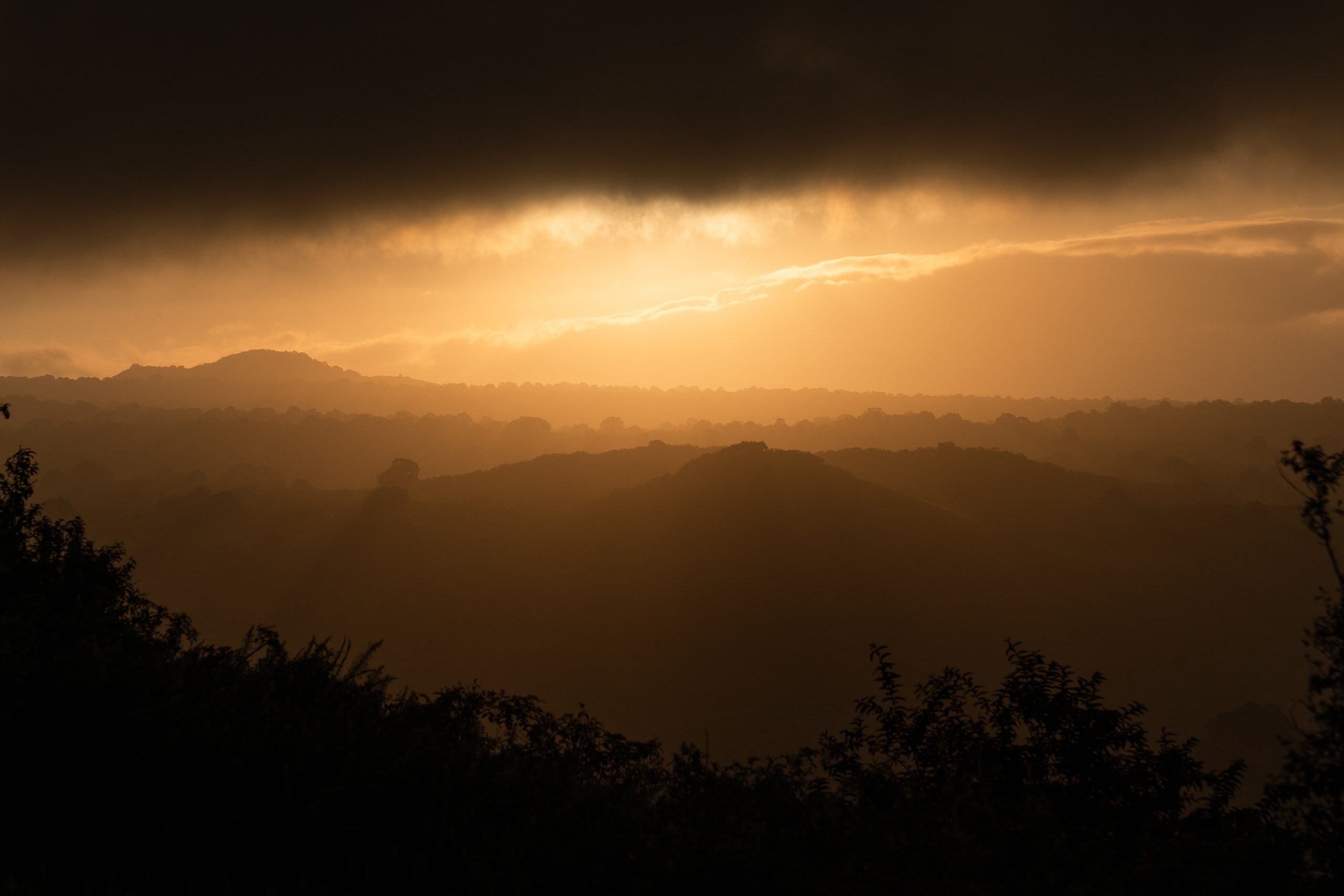
An information session was hosted on Tuesday, September 10th. View the recording here.
**The application for participation in 2025 is closed- please consider applying in Fall 2025 and participating in Spring and Summer 2026!**
The application for participation in 2026 will open in August/September 2025.
Overview
The University of Hawaiʻi at Mānoa (UHM) and the Charles Darwin Foundation (CDF) in Galápagos are excited to offer an immersive, experiential undergraduate research opportunity that engages both indigenous and western science and culture on island invasion biology in the Galápagos and Hawaiian archipelagoes. This two semester research experience includes: (i) a required Spring lab and lecture course in Island Invasion Biology, and (ii) an eight week, immersive, all expenses paid summer research experience in Galápagos. Embracing traditional Hawaiian knowledge and Western science, this unique program aligns with UH Mānoa’s strategic goal to becoming a Native Hawaiian Place of Learning (NHPoL), and combines scientific exploration with Hawaiian ways of knowing to weave indigenous and Western knowledge systems to better understand and manage invasive species in Pacific Island ecosystems. This program will enable undergraduate students to engage in international, faculty mentored research via a transformative journey that promotes deeper connections to ʻāina (land/sea) and kānaka (people) communities, and mālama ʻāina (stewardship of places and people).
Spring 2025 Island Invasion Biology Course
This course on Island Invasion Biology at the University of Hawaiʻi at Mānoa (UHM) is designed to provide a broad overview of the ecology and management of invasive species in island ecosystems, and will serve as the foundation for your summer research experience with the Charles Darwin Foundation (CDF) in Galápagos. Overall, the course and research experience are designed to equip students with essential knowledge and skills to understand the complex challenges posed by invasive species in tropical island ecosystems. Importantly, students will develop a sense of environmental stewardship through the principles of mālama ʻāina to gain an appreciation for Hawai‘i’s people and ecosystems. Learning opportunities will be focused on the principles, theories and practical applications of invasive species, along with their societal, ecological, evolutionary, and environmental impacts and management options, to gain a deep understanding of invasions in island ecosystems. The course aims to provide an understanding of the ethical responsibilities and conservation principles associated with place-based indigenous resource management and pono science. Hawaiʻi and Galápagos provide excellent model systems due to their geographic isolation, diverse ecosystems, and the historical and ongoing challenges posed by invasive species. The course emphasizes the unique cultural and ecological context of Hawaiʻi while connecting it to the broader global context of invasive species research, making it relevant to the local community and promoting a deeper understanding of the importance of preserving native Hawaiian environments in line with UHM’s commitment to becoming a Native Hawaiian Place of Learning (NHPoL).
The laboratory component of this course explores island invasion biology through both a group project and development of individual research proposals to be conducted in the Galápagos and/or Hawaiian Islands. Throughout the semester, you will establish connections with UHM and CDF research mentors that will be instrumental in shaping your research projects, fostering place-based mālama ʻāina principles, and ensuring that your fieldwork aligns with pono science and ongoing research on invasive species. Many of the assignments will be centered around developing your research proposal and completing the group project, including the selection of mentors, creating outlines, and several draft proposals. You will explore the fundamentals of experimental design, data collection, indigenous resource management, statistical analyses, and the ethical and responsible conduct of scientific research. Through the process of working on your group research project you will develop skills in conducting fieldwork, data analyses, presentation, and writing, which will be foundational in the concurrent development of your individual research proposals. There will be 1-2 required field days on a Saturday during the semester (dates TBD based on student availability).
Summer 2025 Research in Galápagos
In Summer 2025, students will have the opportunity to travel to Galápagos for an immersive, 8-week research experience (costs associated with travel, lodging and a summer stipend will be covered for each student). This is a unique opportunity to conduct field research in one of the world’s most iconic island ecosystems. Over the course of eight weeks, students will work closely with CDF experts and UHM faculty mentors to conduct independent invasion biology research projects while exploring the Galápagos Islands’ unique flora and fauna and gaining invaluable hands-on research experience. The Spring 2025 lab component of this research experience will center around finalizing a proposal and working collaboratively with your CDF and UHM mentors so you are ready to conduct your project when you arrive. Students traveling to Galápagos in Summer 2025 are encouraged to continue working with their UHM and CDF mentors after returning to finalize and publish their research findings.
Target dates for the research experience in Galápagos are June and July of 2024; actual departure and return dates will be confirmed in the Spring 2025 semester.
Program Personnel
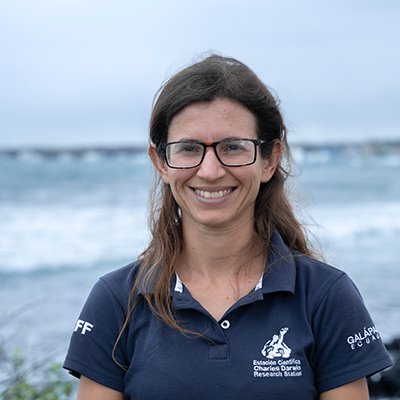
Miriam San José serves as an Investigator in the Terrestrial Invasive Species and Restoration of Scalesia Forests program. Since 2021, when she joined the Charles Darwin Research Station, she has been dedicated to generating, analyzing, and communicating information regarding the impacts of invasive animal and plant species on Galapagos biodiversity, along with the effects of restoration actions over time. Her expertise lies in tropical plant and animal ecology, ecological restoration, and landscape ecology. With over 15 years of experience, Miriam has conducted research projects in tropical areas spanning Mexico, Costa Rica, and Ecuador (Galapagos). She earned her Biology degree from the National University of Mexico (UNAM) and completed both her master’s and doctoral studies at the Institute for Research in Ecosystems and Sustainability (UNAM). Her post-doctoral research was conducted at the University of Hawai‘i’s Lyon Arboretum, USA.
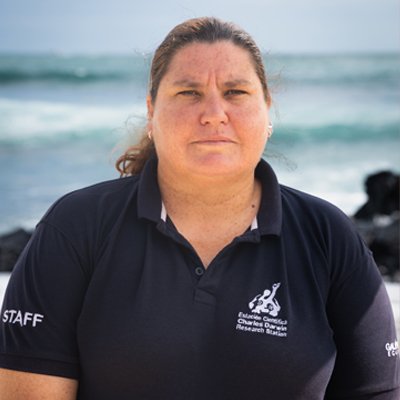
Inti is a HSE part IV commercial diver, a Scientific Diver and PADI instructor and has dedicated her career to the conservation of marine ecosystems. Inti has worked all around the world from the remote islands of Orkney in Scotland to the Great Barrier reef in Australia. Inti joined CDF in 2010 and worked on shark tagging, sea turtle and subtidal ecological monitoring before completing her PhD on Marine Invasive Species. She now leads the Marine Invasive Species and the long term Subtidal Ecological Monitoring Programmes as well as being the science group coordinator for the Eastern Tropical Pacific Marine Corridor initiative (CMAR). Her research portfolio revolves around the role humans play in changing the natural world, particularly in marine ecosystems, and how science can influence management and policy. In recent years she has focused her research on marine invasions in Marine Protected Areas. She is particularly interested in both the consequences of invasions as well as the informed interventions to prevent and mitigate the impacts of these species and other anthropogenic impacts such as climate change. She is a member of the IUCN (SSC) Invasive Species Specialist Group, a National Geographic Explorer, and a member of the Explorers Club.
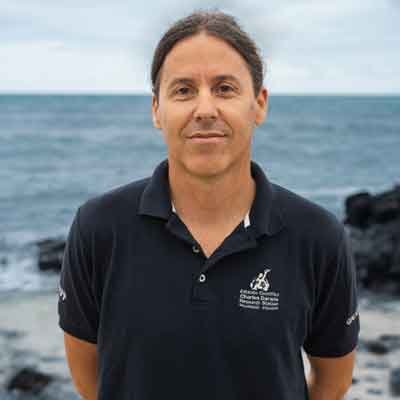
Nico Moity is a Marine Biologist at the Charles Darwin Foundation, where he has worked since 2015 to conserve and understand Galápagos marine ecosystems. He holds a Master’s in Biodiversity, Conservation, and Management of Species and Habitats from the University of Alicante. His research focuses on understanding the complex relationships between natural and anthropogenic factors in coastal and marine ecosystems, including the impacts of climate change. With over 100 publications and experience in more than 25 research projects, Nico is a leader in marine ecology, geospatial analysis, and conservation planning.
Nico is an editor for Oceanography and the Galapagos Atlas, and a member of the MBON Pole to Pole of the Americas, GEO BON Ecosystem Services WG, IABO, MICA-IUCN Mangrove Specialty Group, Global Mangrove Alliance, and the Marine Anthropause Research Synthesis Project. He established a climate change monitoring network in the Galápagos Marine Reserve and develops ways to prioritize conservation areas. Nico’s work also addresses sustainable fisheries, aiming to create equitable and resilient seafood systems while protecting biodiversity.
My research focuses on the ecology of invasive species. Invasive species are organisms that spread extensively after being introduced to a new geographic region. Over the past century, humans have intentionally and unintentionally transported species around the world at an unprecedented rate. Most introduced species never become established, but a few spread successfully and cause major economic and ecological harm. I am interested in factors and processes that influence the success and failure of invasions. Paficic Islands appear to be especially susceptible to invasive species problems, making them an ideal setting for this research.
I am broadly interested in the evolution, ecology and conservation of insects. Projects in the lab often incorporate multiple themes pertaining to empirical research and to threatened species or the effective control of invasive species. By including theoretical and applied aspects in our research, we hope to increase the relevance of our work. Through the University of Hawaii Insect Museum (add link), I help maintain a broader resource available to a swath of researchers with applications to most entomological work in Hawaii. Mostly I enjoy being part of a group that is productive and has fun together in the lab and doing fieldwork!
My main interest is plant ecology, especially aspects of reproductive ecology that influence plant population and community dynamics and are relevant to conservation. Much recent work focuses on how changes in animal communities (pollinators, seed dispersers, and seed predators) affect plant recruitment from seed. I am also increasingly interested in restoration ecology, both as a conservation technique and as a means to learn more about basic ecological processes.
Dr. Frankʻs fundamental research goals are to identify environmental drivers of microbial dynamics and to characterize the impact of microorganisms on biogeochemical cycling in mineral-hosted ecosystems from mountain ridges to mid-ocean ridges. Frank focuses on understanding the specific biogeochemical redox reactions that occur in these ecosystems, the kinetics of these processes, the factor(s) most likely governing activity at in situ conditions, the taxonomy and physiology of the organisms responsible, and the extent to which they influence the ecosystem as a whole. Her work is focused on environmentally tractable ecosystems in Hawai’i (e.g. coastal estuaries – fishponds, terrestrial agricultural systems – taro patches and dryland cropping systems, and groundwater aquifers). Understanding the structure and impact of microbes in native ecosystems will help to develop a valuable framework to evaluate overall ecosystem health and inform current monitoring, restoration, cultivation, and management of Hawaiian ahupuaʻa (watershed) resources. The direction and scope of work is also driven by the input and needs of ‘āina-based (land-based) community organizations and stakeholders. This research provides a unique vehicle for bridging the fields of physical and social science, with culture.
My educational endeavors involve designing collaborative research and outreach programs to achieve broader impacts, and creating professional development opportunities for graduate and undergraduate students, especially those that help integrate different knowledge systems and ways of knowing. Engaging all stages of the learning continuum, I strive to incorporate community-based participatory research as an approach to public science education and outreach. I am also very interested in designing learning environments that explore and encourage creativity, synergies between science and art, service, and civic engagement as integral elements of science.
Research in the laboratory addresses both basic and applied ecology at scales ranging from local to global. My primary research focus is the ecology and biogeochemistry of terrestrial ecosystems, with emphasis on native and managed forest ecosystems in Hawaii and throughout the Pacific. Much of my research involves quantifying pools, fluxes and allocation of carbon and nutrients in terrestrial ecosystems to examine their plasticity and response to a suite of global change variables, using Hawaiian forests as model study systems for asking globally relevant questions. I am particularly interested in how climate change, invasive species, disturbances such as wildfires, and their interactions impact plant-soil-atmosphere exchanges of carbon, water, and nutrients. I also conduct more applied research on the conservation and restoration of native Hawaiian terrestrial ecosystems.
Dr. Noelani Puniwai is passionate about cultivating the next generation of students to mālama ʻāina. She has been trained academically (PhD in Natural Resources and Environmental Management, UH Mānoa; MSc. in Environmental Science, Washington State Univ; BA in Marine Science, UH Hilo) to practice malama ‘āina/kai. Yet through her experiences in her culture, science training, and student mentorship, she’s recognized that feeling aloha ‘āina, he alo a he alo, face to face must also be practiced, moving beyond exclusively intellectual pursuits. Her research interests include coastal ecosystems, cultural geography, knowledge co-production, and seascapes. Noe believes that we can use the rigor and methodologies of pono science, the foundational wisdom of our kūpuna, and our experiential daily practice of aloha ‘āina to awaken responsible action for the future of our Hawai’i.
I am a restoration ecologist and have conducted all my research in the Neotropics where I have evaluated numerous methods to facilitate and jump-start forest recovery processes. I graduated from the University of Texas at Austin with a B.S. degree in Botany and went on to get my M.S. and Ph.D. in Plant Biology from the University of Illinois at Urbana-Champaign. Between 2006-16 I was the Director of the Las Cruces Biological Station and Wilson Botanical Garden in southern Costa Rica – a field research station owned and operated by the Organization for Tropical Studies. More recently I taught as a visiting professor at the American University of Beirut in Lebanon before taking over as Director of Lyon Arboretum, a research unit of the University of Hawai’i at Mānoa. Since 2021 I took over as the Executive Director of the Charles Darwin Foundation for the Galapagos Islands.
I am a Ph.D. student in the Marine Biology Graduate Program at the University of Hawai‘i at Mānoa, working in the lab of Dr. Alison Sherwood. My research focuses on understanding the biogeography, dispersal, and impacts of invasive algal species. My background is in coastal oceanography and kelp forest ecology. In 2024, I served as a teaching assistant for the Galápagos NSF-IRES research experience and accompanied students during their 8-week stay in the archipelago. I will continue in this role in the upcoming year.
Application
**To be eligible to apply students must be enrolled as a classified undergraduate student at the University of Hawaiʻi at Mānoa and graduating no earlier than December 2025 (all majors are invited to apply).**
**This course will also be offered in 2026. Students wishing to participate in that year are still encouraged to apply as are students who are unable to commit to travel during the summer months.**
Before starting the submission process, make sure to get a few things ready:
-
- Resumé/CV (attachment, optional)
- Transcript (attachment, downloaded from STAR, required)
- 2 professional references (Name and email, required)
Priority will be given to Native Hawaiian and Pacific Islander students, but all students from all majors at UHM are encouraged to apply. Applicants must be citizens, nationals, or permanent residents of the United States.
There are several short answer prompts in this application, you should plan to spend at least an hour completing them. You do not have to complete this in one sitting and can save your progress and return to the application.
A subset of students will be invited to participate in a community workday at Ulupō on Saturday October 12, 2024. More information can be found here.
For any questions please contact Jimmy Fumo (jfumo@hawaii.edu)
Return here to apply next year!
Previous years
 photo credit: Aaliyah Thomas
photo credit: Aaliyah Thomas
Projects
Creating the Ka‘ao
All students focused on their ka‘ao as well on their research project. The ka‘ao documents the journey of discovery, thereby crafting the story of the huakaʻi (journey) to and from the Galápagos Islands through a Native Hawaiian cosmological and cultural perspective. As such, students created the kaʻao (legend, epic tale) of this huakaʻi through writing, photography, videos, or other creative media using Hawaiian epistemology and ways of knowing and doing. All participating students and faculty experienced a new culture in Galápagos on this huakaʻi to a distant Pacific Island chain.
Terrestrial Invasion Ecology
Students focusing on this project aimed to understand the history of invasion on the uninhabited island of Santa Fé. Feral goats were removed from the island about half a century ago and giant tortoises were re-introduced in the last decades. Student projects focused on the effect of feral goal removal as well as tortoise and iguana presence on the plant communities of the island.
Photo credit: Bernie Jacome
Marine Invasions
Students focused on this project continued research to understand the extent and impact of non-indigenous species on marine ecosystems of the Galápagos Marine Reserve, particularly the green alga Caulerpa racemosa. They also conducted experiments using the Charles Darwin Foundation (CDF) benthic data to conduct species distribution modeling for the species throughout the archipelago. Students also used instrumentation to conduct salinity surveys at Playa de la Estación near CDF to map the occurrence of Submarine Groundwater Discharge.
Photo credit: Andres Cruz
Ornithology and Entomology
Students focused on this project got a first-hand look at the challenges involved in researching techniques to reduce the impacts of the invasive Avian Vampire Fly, Philornis downsi, on Darwin’s finches and other small land birds. Students participated in research to understand the biology of P. downsi and improve techniques for captive breeding flies, this with the aim of ensuring that sufficient flies are available for testing potential control methods. In the field, students participated in research to improve current trapping methods and map the hatching time for the species.
Photo credit: Carlos Espinosa
Charles Darwin Foundation Principal Investigators
Dr. Charlotte Causton
Dr. Causton has worked with the Charles Darwin Research Station in different projects since 1997, including terrestrial invertebrate research programs. She has extensive experience developing methods for controlling invasive insects and restoring ecosystems in areas of conservation importance. She oversaw the biological control program against the cottony cushion scale using the Australian ladybug and is currently coordinating an international effort to control the population of the invasive Philornis downsi fly, which is threatening many endemic bird species in Galápagos.
Dr. Heinke Jäger
After working eight years in agricultural research at the University in Kiel, Germany, Heinke studied biology at the Universities of Konstanz and Oldenburg, Germany. She started working at the Charles Darwin Foundation in 1998, first on the introduced quinine tree (Cinchona pubescens) and then on rare and endangered plant species. After receiving her PhD from Technical University Berlin, Germany, she carried out her postdoctoral research on invasive Galapagos species at Brown University, USA. She is now a senior scientist at CDF and her research is focused on investigating invasive terrestrial plant and animal species and the restoration of the endangered Scalesia forests in Galapagos. This research includes estimating the distribution of these species, vegetation mapping, evaluation of the impacts of invasive species and the impacts of their control on resident species, soil and microclimate, as well as the restoration of invaded ecosystems.
Dr. Inti Keith
Inti has worked with the CDRS in different marine projects since 2010, including shark tagging, sea turtle monitoring and ecological monitoring before completing her PhD on Marine Invasive Species in the Galápagos Marine Reserve. She now leads the Marine Invasive Species Programme and the long term Subtidal Ecological Monitoring Programme as well as being the science group coordinator for the Eastern Tropical Pacific Marine Corridor initiative (CMAR). Her interests lie in understanding the current status of the Galápagos Marine Reserve and evaluate the impacts non-native species can have on marine biodiversity, ecosystem services and the health of the GMR. As part of her research she is interested in the connectivity that exists between the different Marine Protected Areas in the region, which is why she has expanded her research throughout the Eastern Tropical Pacific region.
She is a member of the IUCN Species Survival Commission (SSC) Invasive Species Specialist Group and the Galápagos Plant Specialist group as well as having ongoing collaborations with the Smithsonian Environmental Research Center (SERC), Southampton University and the University of Malaga.

